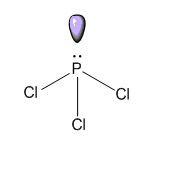
What kind of a molecule in $\text{PC}{{\text{l}}_{\text{3}}}$?
A.) Ionic
B.) Polar covalent
C.) Non- polar covalent
D.) Coordinate
Answer
548.7k+ views
Hint: Bond polarity is determined by electronegativity difference between the atoms, while polarity of a molecule is determined by dipole moment.
\[\text{PC}{{\text{l}}_{\text{3}}}\] Shows structural similarity with $\text{N}{{\text{H}}_{\text{3}}}$ and both the molecule are polar molecule.
Complete Solution :
Dipole moment is a vector quantity, and the dipole moment of a polar molecule depends on its geometry. A symmetrical molecule or having a regular geometry, is non- polar even though it contains polar bonds because in a symmetrical bond dipole of all the bonds cancel out by each other. Only the molecule which has an asymmetrical shape has a dipole moment.
- In $\text{PC}{{\text{l}}_{\text{3}}}$, the central phosphorus atom is attached with three chlorine molecule by covalent bond and, has a lone pair. $\text{PC}{{\text{l}}_{\text{3}}}$ has distorted structure due to the presence of lone pairs of electrons.

(A) $\text{PC}{{\text{l}}_{\text{3}}}$ Is contains three covalent bond which are formed by equal sharing of electron in between phosphorus atom and chlorine atom, hence it’s a covalent molecule.
(B) $\text{PC}{{\text{l}}_{\text{3}}}$ Molecule is an asymmetrical molecule, and has a net dipole moment. So, this is a polar covalent molecule.
(C) Due to the absence of molecular symmetry, $\text{PC}{{\text{l}}_{\text{3}}}$ has a net dipole moment, so it is a polar molecule.
(D) Coordinate bonds are formed by unequal sharing of electrons in between the two atoms. In $\text{PC}{{\text{l}}_{\text{3}}}$ only covalent bonds are present hence it is a covalent molecule.
So, the correct answer is “Option B”.
Note: - Dipole moment in a polar covalent bond is equal to the product of induced charge on covalently bonded atoms and their intermolecular distance.
-Dipole moment depends upon the symmetry of the molecule, and symmetry of the molecule is mainly determined by the presence of lone pairs and bond pairs of central atoms.
\[\text{PC}{{\text{l}}_{\text{3}}}\] Shows structural similarity with $\text{N}{{\text{H}}_{\text{3}}}$ and both the molecule are polar molecule.
Complete Solution :
Dipole moment is a vector quantity, and the dipole moment of a polar molecule depends on its geometry. A symmetrical molecule or having a regular geometry, is non- polar even though it contains polar bonds because in a symmetrical bond dipole of all the bonds cancel out by each other. Only the molecule which has an asymmetrical shape has a dipole moment.
- In $\text{PC}{{\text{l}}_{\text{3}}}$, the central phosphorus atom is attached with three chlorine molecule by covalent bond and, has a lone pair. $\text{PC}{{\text{l}}_{\text{3}}}$ has distorted structure due to the presence of lone pairs of electrons.

(A) $\text{PC}{{\text{l}}_{\text{3}}}$ Is contains three covalent bond which are formed by equal sharing of electron in between phosphorus atom and chlorine atom, hence it’s a covalent molecule.
(B) $\text{PC}{{\text{l}}_{\text{3}}}$ Molecule is an asymmetrical molecule, and has a net dipole moment. So, this is a polar covalent molecule.
(C) Due to the absence of molecular symmetry, $\text{PC}{{\text{l}}_{\text{3}}}$ has a net dipole moment, so it is a polar molecule.
(D) Coordinate bonds are formed by unequal sharing of electrons in between the two atoms. In $\text{PC}{{\text{l}}_{\text{3}}}$ only covalent bonds are present hence it is a covalent molecule.
So, the correct answer is “Option B”.
Note: - Dipole moment in a polar covalent bond is equal to the product of induced charge on covalently bonded atoms and their intermolecular distance.
-Dipole moment depends upon the symmetry of the molecule, and symmetry of the molecule is mainly determined by the presence of lone pairs and bond pairs of central atoms.
Recently Updated Pages
Master Class 12 Business Studies: Engaging Questions & Answers for Success

Master Class 12 Economics: Engaging Questions & Answers for Success

Master Class 12 English: Engaging Questions & Answers for Success

Master Class 12 Maths: Engaging Questions & Answers for Success

Master Class 12 Social Science: Engaging Questions & Answers for Success

Master Class 12 Chemistry: Engaging Questions & Answers for Success

Trending doubts
What is meant by exothermic and endothermic reactions class 11 chemistry CBSE

Which animal has three hearts class 11 biology CBSE

10 examples of friction in our daily life

One Metric ton is equal to kg A 10000 B 1000 C 100 class 11 physics CBSE

1 Quintal is equal to a 110 kg b 10 kg c 100kg d 1000 class 11 physics CBSE

Difference Between Prokaryotic Cells and Eukaryotic Cells




